|
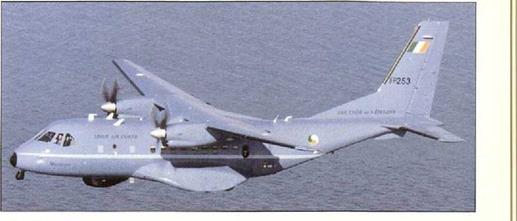
The Irish Air Corps is unique in operating two CN-235MP maritime patrol aircraft, which monitor Irish waters and the country’s EEZ responsibilities.
|
|
he CN-235 igh: tact cal transport was designed and developed under a joint initiative by Spain’s CASA and Indonesia’s IPTN, They founded the Airtech concern in 1980 to develop a robust aircraft that could serve both as a mi’lta^y transport and a regional airliner. The CN-235 has all the classic elements of a nr. il tary transport, including a rear – loading ramp, high wing ano rough-field landing gear. The aircraft Is powered by a pair of proven General Electric CT7 turboprops, and is capable of dropping troops and supplies from its side doors and rear ramp. Military design features predom neted in the CN-235 and it had ittle success in the com – mercia market, However is has become popular with air forces worldwide, fitting into a niche below the capacity and costs of the C-130 Hercules.
Two prototypes were built with CASA’s example making the first flight on 11 November 1983. The irit:al production variant was the CN-235 Series 10, powered by CT-7A engines. Military variants were designated Cll-235M-I0s and ai’craft were delivered to Botswana, Indonesia, Saudi Arabia, Spain (as the VIP-configured T.19A) and the UAE The improved CN-235M-100 followed, powered by uprated CT7C engines. The Series 100 introouced a major step forward in performance, IPTN-built a’rcraft were designated CN-235IVl-110s. Customers nclude Chile, Ecuador, France, Gabon, Indonesia, Ireland, Morocco, Oman, Papua New Guinea, South Africa, South Korea, Spain (T.19B), Turkey and the UAE.
The CN-235M-200 (IPTN -220) introduced higher operating weights and still bettei performance. It has been acquired by Indonesia and Malaysia.
Turkey signed a licence-p’oduction deal in 1990 to bu Id 50 of its 52 aircraft. These were delivered between 1992 and 1998. Manufacturer TAI is now working on a maritime patrol version for Turkey. CASA developed its own maritime patrol version, the CN-235MP Persuader which is in service in Ireland. IPTN has also been working on its own maritime patrol version, the CN-235MPA, but its development has been slow and only a prototype has been built.
In 1997 CASA announced the independently – developed C-295. The C-295 Is 10 ft A in (3,05 m) longer than the CN-235, ncreasinc its payload by over 50 per cent. The C-295 is powered by two Pratt & Whitney Canada PW127G turboprops, and is fitted with a Sextant Topoeck EFIS cockpit. A technology demonstrator made its maiden flight on 28 November 1997 and the first production-standard C-295 flew on 22 December 1ЭЭ8.
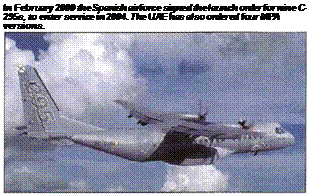 Specification CASA (Airtecli) CN-235-100 Powcrplant: two l394-kW(1B70-hpJ General flectric CT7-9C turboprops Dimensions: span 25.81 m (84 ft 8 in); length 21.43 m (70 ft 2V in); height 8.1 (5 m (?G ft 10 ini: Weights: empty equipped 8800 <g (13,400 lb); maximum take-off 160(13 kq (35773 1Ы Performance: maximum cruising speed 422 kith (76? mpf); maximum rate of climb at sea level 579 m (1,900 ft) per minute; service cei’ing 6860 n 122,500 ft); maximum range 4352 km (2704 miles) with a 3550-kg (7.826-payload)
Specification CASA (Airtecli) CN-235-100 Powcrplant: two l394-kW(1B70-hpJ General flectric CT7-9C turboprops Dimensions: span 25.81 m (84 ft 8 in); length 21.43 m (70 ft 2V in); height 8.1 (5 m (?G ft 10 ini: Weights: empty equipped 8800 <g (13,400 lb); maximum take-off 160(13 kq (35773 1Ы Performance: maximum cruising speed 422 kith (76? mpf); maximum rate of climb at sea level 579 m (1,900 ft) per minute; service cei’ing 6860 n 122,500 ft); maximum range 4352 km (2704 miles) with a 3550-kg (7.826-payload)
Armament; MPA versions have two hardpoints under wing. Indonesian development aircraft fitted with Exocet or Harpoon missiles
|
China
Light-weight combat aircraft
|
|
Posted by admin
in AIRCRAFT on November 3, 2015
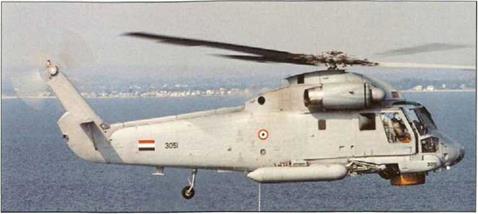
veteran of the Vietnam war, and almost retired from US Navy service, Kaman’s venerable SH-2 Seasprite is enjoying a new lease of life. Though the original design dates to the 1950s the Seasprite has found a new niche for itself as a compact shipboard helicopter, with advanced on-board systems.
The prototype SH-2 flew as the HU2K-1 in July 1959, the first Kaman helicopter to have a conventional rotor configuration. The H-2 designation was applied in October 1962 ana Kaman built 100 single- engined UH-2Ar and UH-2B aircraft for the US Navy. In 1970 the redesigned, twin-engined SH-2D was adopted for the ASW role, as the Navy’s LAMPS aircraft – a small helicopter capable of operating from the decks of smaller frigates and destroyers. The definitive LAMPS I version was tho SH-2F Seasprite, which entered service in 1973. This version was powered by two General Electric T58-GE-8F turboshafts, and was fitted with an LN 66HP search radar, a towed MAD, side-mounted sonobuoy rack, tactical mission system. In 1981 Kaman re-opened the Seasprite line to build 60 new SH-2Fs for the USN
In 1985 the Navy began to upgrade its SH-2Fs to SH-2G Super Seasprite standard, re-engining them with T700 turboshafts and significantly increasing performance. The first SH-2F testbed flew in April 1985 and the first production-standard SH-2G conversion flew in March 1990. During the mid- to Iate-I990s the US Navy began to retire
Egypt has acquired 10 SH-2G(E)s to operate from its former-US Navy ‘Knox’-class frigates. The Seasprites are equipped with a dipping sonar.
many of the Oder, smaller vessels which deployed SH-2s, and the Seasprite’s place in the feet was increasingly taken over by the Sikorsky SH-60. Currently the US Navy has just two Reserve squadrons equipped with the SH-2G,
However, the surplus of ex-US Navy aircraft allowed Kaman to embark on an aggressive export sales campaign with the Seasprite. In February 1995 Egypt ordered 10 SH-2(GE)s – remanufactured from SH-2F airframes – and they were delivered in 1997/98. Australia has ordered 11 SH-2G(A)s to operate from its ANZAC class and FFG frigates. The first (remanufactured) SH-2G(A) flew in October 1999 and the first delivery was made to the reformed No 805 Sqn in March 2001 The Australian aircraft are fitted with the Litton ITAS advanced cockpit and mission system. The Royal New Zealand Navy has ordered five new-bude SH-2G(NZ)s and deliveries began in 2001. An interim batch of four unmodified SH-2Fs was acquired to provide training and familiarisation before the RNZN’s Super Seaspiites were delivered.
New Zealand took delivery of four Т-58-powered SH-2F Seaspiites as a ‘bridging loan’ until its full – standard SH-2G(NZ) aircraft could be delivered.

iven the unflattering NATO code-name ‘Hokum’, the Ka-50 was developed as a rival to the Mil Mi-28 in the competition to provide в new battlefield he icopter for the Soviet armed forces. Realising that it would be difficult to achieve АЧ-64 levels of performance with existing Soviet technology and equipment, Kamov followed an individualistic course, retaining its trademark coaxial contra-rotating rotor configuration. This was felt to give a more compact, more agile airframe, and to reduce vulnerability to hostile fire. To minimise weight, Kamov also decided to design a single-seat helicopter, using the contra-rotating coaxial’s inherently good handling characteristics to make this possible, and drawing on its experience of sophisticated auto-hover systems on Kamov’s naval helicopters, The single- pilot cockpit was successfully demonstrated on the testbench, and in a modified Ka-29TB. A novel feature rs the pilot’s Severin/Zvezda K-37 ejection seat. The ejection sequence begins with automatic rotor separation, then jettisons the doors before a rocket pack drags the seat from the helicopter.
The A80 prototype made its maiden flight on 27 July 1982. The competitive evaluation ended in October 1986 and the Ka-50 was reportedly selected in preference to the Mil Mi-28, although the
requirement was then revised, leading to a new competition between the night-attack optimised Mi-28N and the Ka-5ON,’Ka-50Sh, wnic’n feature advanced new avionics.
Customer resistance has led to the development of a number of two-seat derivatives of the Ka-50, including the tardem-seat Ka-50-2 end Ka-50-2 Erdogan (this to meet a Turkish requirement) and the Ka-52 Alligator, with side-by-side seats, a mast – and roof-mounted sighting system and advanced night attack systems.
The tube-launched, laser-beam-riding Vikhr (NATO АТ-Э ‘Whirlwind’) missile forms the Ka-bO’s primary armament. Sixteen can be carried, augmented by the built-in 30-mm cannon. Developed for the BMP AFV, the gun has variable rates of fire and selective feed from two 250-round ammunition boxes. The gun is installed on the starboard side of the fuselage below the wing root and is electro- hydraulically driven and can be traversed through 30° in elevation, and can also move 155 in azimuth. Combat survivability is enhanced by the IR suppres sors in the exhaust assemblies, the heavily armoured pressurised cockpit, the foam-filled, selfsealing fuel tanks. Wingtip pods house chaff/flare dispensers.
 Specification: Kamov Ka-50 Powcrplant: two 1650-kVV {2.22o-hp) Klimov (I sow) TV3-1 )7VK turboshafts Dimensions: rotor diameter, each 14.50 m (45 (t 6.9 in), length overall, rotors turning 15.00 її (52 ft 5.9 irj. and fuse ape excluding probe anrl g. m 13.50 in (44II 3/ in); height 5.40 m Г / ft 0.6 in) Specification: Kamov Ka-50 Powcrplant: two 1650-kVV {2.22o-hp) Klimov (I sow) TV3-1 )7VK turboshafts Dimensions: rotor diameter, each 14.50 m (45 (t 6.9 in), length overall, rotors turning 15.00 її (52 ft 5.9 irj. and fuse ape excluding probe anrl g. m 13.50 in (44II 3/ in); height 5.40 m Г / ft 0.6 in)
Weights: maximum take-off 7500 kg 116,534 lb) Performance: maximum level speed 350 krh (217 mph) maximum vertical rate of climb at 2500 m (8,200 ft) 600 m (1.969 ft) per minute, hovering ceiling 4DC0 m (13,125 ft) OGE; combat radus about 250 km (155 miles) Armament: one 2A12 30-mm cannon with two 250-round drums, plus 3000-kg (6,610-lb) stores
Japan
 Basic/advanced training aircraft Basic/advanced training aircraft
|
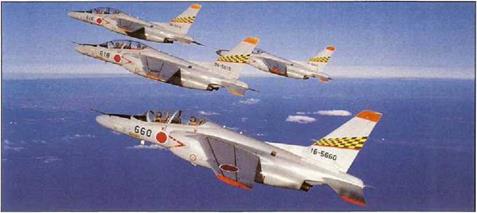
These T-4s wear the yellow and black checkerboard markings of 1 Коки-dan, the JASDF’s 1st Air Wing and its primary jet training unit.
|
|
he Kawasaki T-4 rs an intermediate jet trainer to replace the Lockheed T-33 and Fuji T-1 A/В. Design studies were completed in 1983 and *’our prototypes (designated XT-4) were funded in 1984. The first of these made its maiden fight on 29 July 1985. The T-4 is a conventional design, featuring high subsonic manoeuvrability and docile handling characteristics. It shares a similar high-wing configuration to the Dassault-Dornier Alpha Jet. to which it bears s similar appearance – with pronounced anhedral on the wings and tailplane, and large ‘dog tooth’ leading edges. Visibility for both instructor and pupil is excellent, with a frameless wraparound windscreen and a one-piece canopy, For its secondary liaison role, the T-4 has a baggage compartment fitted in the centre fuselage with external access via a door in the port side.
The T-4 is a collaborative venture, in which Fuji builds the rear fuselage, supercritical section wings and tail unit, and Mitsubishi constructs the centre fuselage and air intakes, Kawasaki builds only the forward fuselage, but is responsible for final assembly and flight test. Virtually all components are indigenously built, and most are locally designed, including the Ishikawajima-Harima F3-IHI-30 turbofan engines. A single underwing pylon on each side can accommodate a 450-litre <99-lmp gal) drop tank, and a centreline pylon can be fitted for a target towing winch, air sampling pod, ECM pod or chaff dispenser.
T-4 production deliveries began in September 1988, to meet an original Japan Air Self Defence Force requirement for some 200 aircraft, replacing the T-33 and Fuji T-1 in the basic training role. By mid-January 2001 212 T-4s had been funded The T-4 is today in service with Nos 31 and 32 Squadrons of No. 1 Air Wing at Hamamatsu, and with some operational squadrons and wings as a liaison aircraft, sometimes wearing the same camouflage scheme and unit markings as the operational aircraft. Nine aircraft serve with the Blue Impulse aerobatic team (No.11 Squadron. No.4 Wing), having replaced T-2s in 1994. These aircraft are modified to carry smoke generators and also have a re-inforced canopy, a revised rudder limiter system, ground-proximity warning system end additional cockpit lighting and instruments to aid aerobatic flight.
An advanced version of the T-4, with more powerful engines and improved avionics, has been offered to the JASDF to replace the ageing and uneconomical T-2 in the advanced training role.
The first and third T-4 prototypes are seen here in the markings of the TRDl development and test wing, where they are retained for trials flying.
|
Specification: Kawasaki T-4 Powerplant: two 16.32-kN (3,671-lb) Ishlkawajima-Hsriina F3-IHI-30 turbofans Dimensions: wing span 9.94 m (32 ft ТА in), length 13,00 in (42 ft 8 in): height 4,SO m 115 ft 14in)
Weights: empty 3/00 <q (8,15/ lb); maximum take-off 7500 kg (16.534 lb)
Performance: maximum love* speed 1038 kmh |645 mph); maximum rate of climb at sea levei 304Я m 110,000 ft) per minute: service ceiling 15240 m (50.000 ft): ferry range 1658 km (1,035 miles) with drop tanks Armament structural provision for up to 2000 kg (4,409 lb) of ordnance on two underwing hardpoinls
|
|

Posted by admin
in AIRCRAFT on November 3, 2015
Posted by admin
in AIRCRAFT on November 3, 2015
|
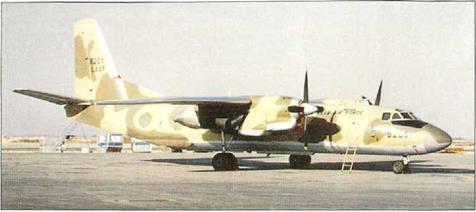
Libya has a small number of An-26 transports. The rear ramp of the ‘Curl’ slides down and then forward along tracks, to lie directly under the fuselage.
|
|
he twin-turboprop Antonov An-24 (NATO code – name ‘Coke’) made its maiden flight on 20 December 1959, and was aimed at an Aeroflot requirement to replace piston-engined 11-14s and 11-12s. Its robustness, strength and performance appealed to military customers, and approximately 1,200 were built by the time production finished in 1978, The major production An-24V variant has seating for 28-40. a side freight door and a convertible cabin.
Although derived from the An-24, the An-26 (‘Curl-A’) is a new design with a fully-pressurised cargo hold, uprated engines and a new rear-loading ramp to facilitate loading from trucks. All An-26s are fitted with an RU-19 turbojet in the rear of the starboard engine nacelle. As well as actirg as an APU, this can be useo as a take-off booster.
A small number of An-26s have been converted as Elint/Sigint/EW platforms. These bear the NATO reporting name ‘Curl-B’. and have a profusion of swept blade antennas above and below the cabin. Some An-26s delivered to Angola and Mozambique were fitted with exterior bomb-racks along the fuselage.
Along with Russia, Ukraine and most CIS states, current An-26 operators include Afghanistan, Benin, Bangladesh, Bulgaria. Cape Verde, China, Cuba,
Congo, Czech Republic, Germany, Ethiopia, Guinea Bissau, Hungary, Iraq, Laos, Libya, Madagascar, Mali, Mongolia, Mozambique, Nicaragua, Poland, Romania, Russia, Serbia, Slovakia, Vietnam, Yemen and Zambia.
The An-32 ’Cline’ replaced the An-26 in production, and offers dramatically improved take-off performance, ceiling and payload, especially under ’hot-and-high’ conditions. The cabin can accommodate up to 50 passengers, 42 paratroops, or 24 stretcher patients and three attendants. The basic production aircraft are fitted with 3812-kW (5,112-hp) AI-20D turboprops. These are mounted above the wing in very deep nacelles to give greater clearance for the incrcased-diameter propellers The An-32B offers uprated engines and Antonov has also developed a water-bomber version (fitted with external water tanks), the An-32P Firekiller, In addition to the air forces of Russia, Ukraine and some CIS states, the An-32 has attracted several military customers including Afghanistan, Bangladesh, Cuba, India, Mongolia and Peru and Tanzania.
China builds ts own military transport version of the An-26 as the Xian Y-7H-500 – while also the building a family of other Y-7 airliner variants based on the civil-standard An-24 airframe.
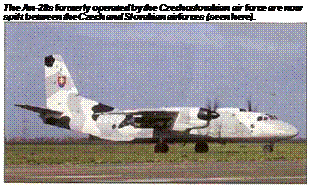 Specification: Antonov An-26B Curl-A’ Powerplant two 2103-kW (2,820-hp) ZMDB Progress (Ivchenko) AI-24VT turboprops, and Specification: Antonov An-26B Curl-A’ Powerplant two 2103-kW (2,820-hp) ZMDB Progress (Ivchenko) AI-24VT turboprops, and
one 7.8b-kN (1,765-lb) Soyuz (Turmanskii) RU-19A-3G0 turbojet
Dimensions: w rig span 29.2C m (95 ft 9.5 in); length 23 80 m (78 ft 1 in), height 8 58 m (28 ft 15 in)
Weights: empty 15400 kg (33,957 Ih); maximum take-off 24400 kg (53,790 lb): maximum payload 5500 kg (12.125 lb) Performance: maximum level speed 540 kmh, (336 mph); range 2550 km (1,585 miles) with maximum fuel or 1100 km (683 miles) with maximum payload
 South Africa Multi-role combat aircraft South Africa Multi-role combat aircraft
uring the 1980s South Africa embarked on an extremely ambitious, and extremely secret, transformation of its Dassault Mirage Ills into a highly-modified and improved family of combat aircraft The international arms embargo against the Apartheid regime made the acquisition of any now aircraft impossible, at a time when South Africa felt it was facing an increasing threat from neighbouring, hostile African nations~The state-owned firm of Atlas Aviation, with considerable help from Israel’s IAI, began to adapt the modified airframe and the improved avionics suite of the IAI Kfir to the South African Air Force’s own aircraft, to produce the Cheetah – in several distinct versions.
The most important of these was the two-seat Cheetah D attack aircraft, based on the Mirage IIIDZ airframe (though a few single-seat Mirage IIIEZs were also converted). Atlas modified approximately 16 aircraft to Cheetah D standard. They resemble the IAI Kfir TC-7, with their distinctive extended cranked noses and canard foreplanes. The nose houses an Elta EL/M-2001В ranging radar and the Cheetah Ds are fitted with refuelling probes. The first converted aircraft was rolled out in 1986 and entered service almost immediately.
Cheetah D development paralleled the singleseat Cheetah E conversions, based on the SAAF’s Mirage INEZ fighters. The Cheetah E had much the same systems fit as the Cheetah D (including an advanced RWR, EW jamming suite and chaff/flare
The Cheetah C is now the sole air superiority fighter in SAAF service, but the aircraft also has a formidable attack capability.
dispensers, and bore a strong resemblance to the Israeli Kfir C7. Both the Cheetah E and Cheetah D were fitted with a new, reprofiled wing with a ‘dogtooth’ leading edge. Sixteen Cheetah Es were built, but they were retired in the early 1990s when a radically superior Cheetah fighter was introduced.
This was the Cheetah СГ which entered service in January 1993. Until then not a single fact about the programme had emerged – this secrecy was doubtless due to the fact that the 38 aircraft used in the Cheetah C conversions were acquired from a source outside South Africa (almost certainly Israel). The Cheetah C was a major step forward because it was fitted with an Elta EL/M-2001 multi – mode radar, and was powered by the more powerful Atar 09K50 engine. The Cheetah C is also stretched, with a plug measuring approximately 58 cm (23 in) inserted between the cockpit and engine intakes The new radar allows the Cheetah C to be armed with the Kentron R-Darter BVR missile, as well as the agile, IR-guided U-Darter dogfight missile, used in conjunction with a helmet-mounted sight.
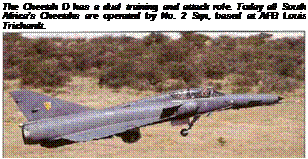 Specification: Atlas Cheetah C Powerplant: one SNECMA Atar 09K50 turbojet rated at 49,03 kN (11,923 lb st| dry and 70.82 kM (1b.873 lb st) with afterburning Dimensions: wing span B.22 in (26 ft 1Ш in); canard foreplaae span 3.73 mil7 It3 in); length including probe 15.65 m (51 ft 4K in): height 4.5 m (14 ft 11 in) Specification: Atlas Cheetah C Powerplant: one SNECMA Atar 09K50 turbojet rated at 49,03 kN (11,923 lb st| dry and 70.82 kM (1b.873 lb st) with afterburning Dimensions: wing span B.22 in (26 ft 1Ш in); canard foreplaae span 3.73 mil7 It3 in); length including probe 15.65 m (51 ft 4K in): height 4.5 m (14 ft 11 in)
Performance: maximum level speed ‘clean’ at 12000 m (39.370 ft). 233Й kmh [1,453 mph); maximum cruising speed at 11000 rn (35,090 ft) 956 kmh (594 mph): service ceiling 17000 m 155.775 ft)
Armament: two internal DEFA 30-тгп cannon plus up to 4000 ky (8,818 lb) of ordnance
Posted by admin
in AIRCRAFT on November 3, 2015
|
|
|
|
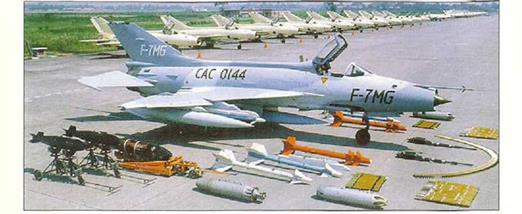
hina was granted ajicence to manufacture the MiG-21F-13 anc its I umanskii R-11F-300 engine in 1961, as the J-7. A Shenyang-built prototype Lew on 17 January 1966 followed by a few development aircraft, and full production began at Chengdu in June 1967. Ihe production-standard J-7I entered service in small numbers anc was replaced by the J-7II, powered by an uprated WP7B turbojet. The J-711 has become the standard production variant for the People’s Liberation Army Air Force, and the baseline for a range of improved export aircraft.
Shenyang used the more advanced MiG-21 MF to develop the J-7III This version is powered by a WP13 engine, has day/night capability thanks to its JL-7 radar, increased fuel capacity and the characteristic enlarged spine of the MiG-21 MF (compared to earlier versions). Flowover, the J-7III has been slow to enter Chinese service and the first examples were not ready until 1992. Mo J 7111s are understood to have been exported.
Albania and Tanzania wore customers for the first export version of the of the J-71, the F-7A. The improved F-7 В (J-711) was delivered to Egypt, Iraq, Sudan and Zimbabwe. The F-7B can be armed with the MAlRA R.550 Magic air-to-air missile (copied in China as the PL-7). A hybrid version has been deliv-
The F-7MG is a development of the J-7//. While it retains the familiar lines of an early-model MiG-21, it boasts an entirely new wing design.
ered to Sr Lanka as the F-7BS. These aircraft have the fuse.-age, tail and systems of the F-7B with the four-hardpoint wing of the F-7M.
Western avionics were incorporated for the first t me in the F-7M Airguard, which was equipped with a GEC-Marconi HUDWAC, a Skyranger ranging radar, air data computer, radar altimeter, IFF and other improved systems. F-7Ms have been delivered to Bangladesh, Iran and Myanmar (Burma).
Pakistan has acquired its own version of the F-7M, the F-7P Airguard which can carry four AIM-9 Sidewinder missiles and has a Martin-Baker Mk 10L ejection seat. A developed version of this aircraft, the F-7MP, is equipped with the Italian FIAR Grifo 7 fire-control radar and a further improved (western-sourced) avionics fit.
Shenyang has moved on to develop Ihe export – driven F-7MG with an entirety new double delta wing and WP13F engine. Pakistan is reported to be acquiring up to 100 aircraft as the F-7PG, while the PLAAF aerobatic team ‘1st August’ is equipped with an equivalent version, the J-7EB.
China has developed a two-seat training version of the J-7, the JJ-7 (export version FT-7). This aircraft has been developed by Guizhou and is based on the J-7ll/MiG-2lUS.
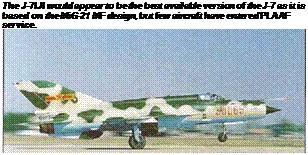 Specification: Chengdu F-7M Airguard Powerplant: one 59.82-kll (13,448 lb st)
Specification: Chengdu F-7M Airguard Powerplant: one 59.82-kll (13,448 lb st)
I iyang |LMC) Wopen-78(BM] turbojet Dimensions: wing span 7 15m {23 ft 5/ in), length 13.95 m (45 ft 9 in) excluding probe; height 4.10 m (13 ft 5/ in)
Weights: empty 5275 kg (11,629 !b); normal take off 7531 kg (16,603 o)
Performance: maximum level speed 2175 kmh (1.350 mph); service ceiling 17500 m (57.420 ft); combat radius 850 km (5?0 miles) on a hi-hi-hi air superiority mission with two AIM-9 missiles and three 500-litre (132-US gal) drop tanks
Armament two Type 30 30-mm cannon with 60 rpg, plus 1000 kg (2,205 lb) of ordnance
Dassault Atlantic, Atlantique
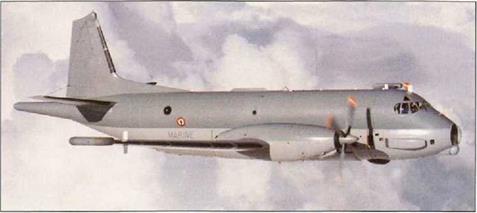
1957 NATO requirement for e long-range maritime patrol aircraft inspired the French-designed Breguet Br.1150 Atlantic. Breguet set up the pan – European SECBAT consortium with partners in Belgium, Holland. Germany and Italy to provide components for the aircraft, which was assembled at Toulouse.
The Atlantic is a twin-turboprop maritime patrol and anti-submarine aircraft, with a crew of 12, It was originally equipped with a Thomson-CSF search radar and US-supplied mission systems, similar to those of the P-2 Neptune. A ‘doublebubble’ fuselage provides for a 9.15-m (30-ft> long internal weapons bay underneath the main cabin floor. The prototype aircraft made rts maiden flight on 21 October 1961. The Atlantic became the standard patrol aircraft for the French, German and Italian navies. It entered service in 1965 with France and German taking delivery of 40 and 20 aircraft, respectively. Another nine were delivered to the Dutch navy between 1969 and 1972 (later replaced by P-З Orions) and Italy took delivery of 18 Atlantics between 1972 and 1974. Beyond the SECBAT partner nations, the only export sale was three former – French aircraft delivered to Pakistan in 1975-76.
Germany converted five aircraft to serve as ‘Peace Peek’ intelligence-gathering platforms, using a US-supplied Sigmt/ЕІІпт system. The ‘Peace Peek’ aircraft are outwardly very similar to the standard Atlantic, but they are fitted with distinctive
The upgraded Atlantique is now the standard maritime patrol aircraft in French service. It is most readily identified by its nose-mounted FUR turret.
underwing antennas. In recent years Italy has upgraded its aircraft, adding a new radar and mission avionics. The upgraded aircraft have ben painted in an overall grey scheme and now carry a prominent antenna housing above the extended dorsal sp:ne fairing.
Dassault took over Breguet in 1971 and it led the effort to develop an improved version of the original Atlantic, the Atfantic INouvelle Generation (AIMGI.
The result of this was the Dassaull Atlantique (or ATL 2) a version of the Atlantic with new avionics and some structural improvements/strengthening. The sole customer for the Atlantique is France’s Aeronavale which acquired 30 aircraft (down from a planned total of 42). A prototype flew in May 1981, the first production standard Atlantique flew in October 1988 and deliveries began in 1989 The final example was delivered in January 1998. Dassault is now offering an improved Atlantique 3 design – with an FFIS cockpit, AF2100 turboprops and an all-new mission system – to replace the first-generation Atlantics in Italy and Germany.
Germany’s Atlantics have been upgraded to carry wingtip ESM pods> and this aircraft is also carrying an undenting FUR pod (to port)
|
Specification: Dassault Atlantique (ATL 2) Powerplant; ‘.wo 4549-kW (6,1 OQ-hp^ Rolls – Royce Tyne RTy.2U Mk 21 turboprops Dimensions: wing span 3745 m (122 ft Ш in); length 3* .71 m (104 ft); height 10.8Э rr (35 ft 8# in)
Weights: empty 2570C ко (56559 lb); normal take-off 46200 kg {101,850 lb)
Performance: maximum level speed 648 kmh 1402 nph); service ceiling 9145 m (30,000 ft); operational radius 1850 km (1.150 miles) a five-hour ASW patrol, or 1110 km (6ЭС miles! for an eight hour patrol Armament: 3606 kg (7.936 lb) internal ordnance. 3500-kg (7.71 B-lb) external ordnance on four underwing hardpomts
|
|
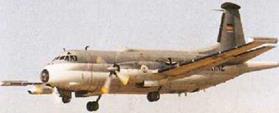
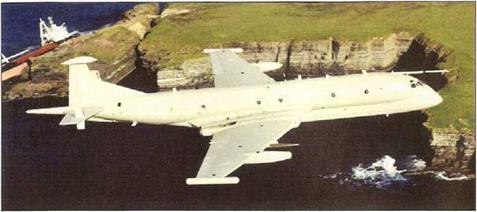
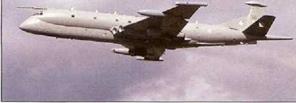 Powerplanr. four 54-kN (12,140-lb) Rolls – Royce RB. 168-20 Spey Mk 250 turbofans Dimensions: soan 33 m (114 ft 10 in), length 38,63 m| -?6 ft 9 in}; height 9.08 m (29 ft 8.5 in) Weights: typical empty 39010 kg 186,000 lb); maximum normal take-off B0514 kg (177,500 lb); Performance: maximum cruising Speed 880 kfJlh (547 mph): economica: cruising speed at optimum altitude 787 kmh [490 mph}; typical patrol speed at low level 370 kmh (230 mph) on two engines; service ceiling 12800 m (42,000 ft); maximum endurance 15 hours Armament maximum ordnance 6124 kg (13,500lb)
Powerplanr. four 54-kN (12,140-lb) Rolls – Royce RB. 168-20 Spey Mk 250 turbofans Dimensions: soan 33 m (114 ft 10 in), length 38,63 m| -?6 ft 9 in}; height 9.08 m (29 ft 8.5 in) Weights: typical empty 39010 kg 186,000 lb); maximum normal take-off B0514 kg (177,500 lb); Performance: maximum cruising Speed 880 kfJlh (547 mph): economica: cruising speed at optimum altitude 787 kmh [490 mph}; typical patrol speed at low level 370 kmh (230 mph) on two engines; service ceiling 12800 m (42,000 ft); maximum endurance 15 hours Armament maximum ordnance 6124 kg (13,500lb)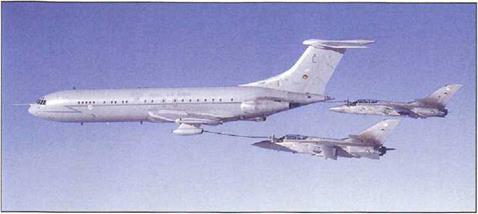
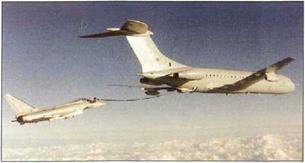
![]() Basic trainer and light attack aircraft
Basic trainer and light attack aircraft Specification: CASA C.101 CC Aviojet Powerplant: one 70.91 – kN J4.,rOO-lb) Garrett TFE731 -5-1J turbofar
Specification: CASA C.101 CC Aviojet Powerplant: one 70.91 – kN J4.,rOO-lb) Garrett TFE731 -5-1J turbofar










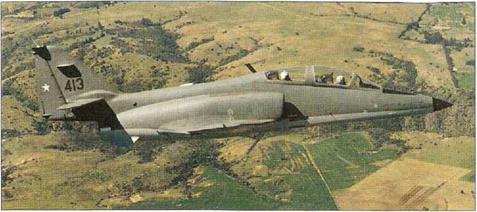
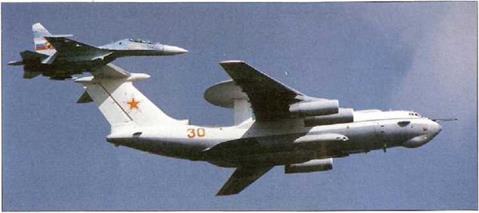
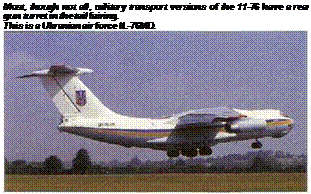 Specification: Ilyushin II-76M ’Candid-B Powerplant: four; 17.68-kN (26,455 lb) PNP° ’Aviadvigataf (Soloviev) D-30KP turbofans Dimensions: wing span 50.50 m (165 It 5 in); length 4S 59 m (152 ft 10k in); height 14.76 m I48 ft 5 in)
Specification: Ilyushin II-76M ’Candid-B Powerplant: four; 17.68-kN (26,455 lb) PNP° ’Aviadvigataf (Soloviev) D-30KP turbofans Dimensions: wing span 50.50 m (165 It 5 in); length 4S 59 m (152 ft 10k in); height 14.76 m I48 ft 5 in)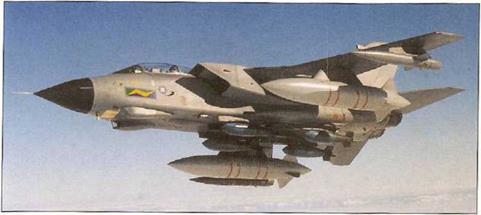
![Panavia Tornado IDS, ECR Подпись: Specification: Panavia Tornado GR.Mk 1 Powerplant: two 71.50-kN (16.07b lb) Turbo- Union RB.199 Mk 103 turbofans Dimensions: wing span 13.91 m (45 it 7/ in] minimum sweep and 8.60 m (28 ft 2/ in) maximum sweep; length 16,72 rti (54 ft 104 in); height 5.95 m (19 ft 64 in) Weights: operating empty 14091 kg {31,065 lb): maximum take-off 27951 kg (61,620 lt>l Performance: limiting IAS 14B2 kmh [921 mph). service ceiling more than 15240 m (50,000 ft); combat radius 1390 km (863 miles) on a typical hMo-hi attack mission Armament: twe 27-mm IWKA-Mauser cannon with 180 rpg; maximum ordnance over 9000 kg (19,841 lb)](/img/1244/image227.gif)
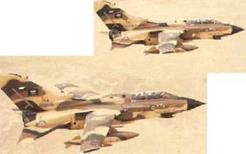


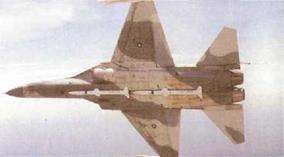
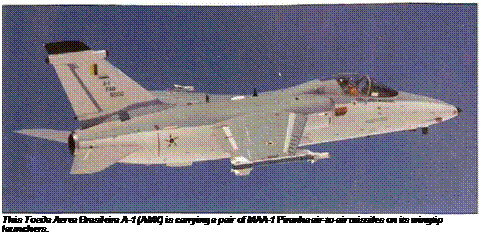


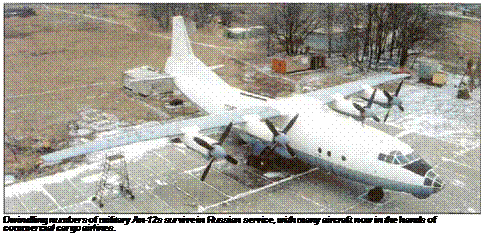
 Specification: Antonov Ait-12BP Cub-A’ Powerplant: lour 2983-kW(4.000-hp)ZMOB Progress (Ivchenko) AI-20K turboprops Dimensions: span 38.00 m (:24 ft 8 in), ienoth 33.10 m (108 ft 7.25 fn); height 10.53 m (34tt5.5 in!
Specification: Antonov Ait-12BP Cub-A’ Powerplant: lour 2983-kW(4.000-hp)ZMOB Progress (Ivchenko) AI-20K turboprops Dimensions: span 38.00 m (:24 ft 8 in), ienoth 33.10 m (108 ft 7.25 fn); height 10.53 m (34tt5.5 in!
 Specification CASA (Airtecli) CN-235-100 Powcrplant: two l394-kW(1B70-hpJ General flectric CT7-9C turboprops Dimensions: span 25.81 m (84 ft 8 in); length 21.43 m (70 ft 2V in); height 8.1 (5 m (?G ft 10 ini: Weights: empty equipped 8800 <g (13,400 lb); maximum take-off 160(13 kq (35773 1Ы Performance: maximum cruising speed 422 kith (76? mpf); maximum rate of climb at sea level 579 m (1,900 ft) per minute; service cei’ing 6860 n 122,500 ft); maximum range 4352 km (2704 miles) with a 3550-kg (7.826-payload)
Specification CASA (Airtecli) CN-235-100 Powcrplant: two l394-kW(1B70-hpJ General flectric CT7-9C turboprops Dimensions: span 25.81 m (84 ft 8 in); length 21.43 m (70 ft 2V in); height 8.1 (5 m (?G ft 10 ini: Weights: empty equipped 8800 <g (13,400 lb); maximum take-off 160(13 kq (35773 1Ы Performance: maximum cruising speed 422 kith (76? mpf); maximum rate of climb at sea level 579 m (1,900 ft) per minute; service cei’ing 6860 n 122,500 ft); maximum range 4352 km (2704 miles) with a 3550-kg (7.826-payload)
![Kaman SH-2 Seasprite Подпись: Specification: Kaman SH-2G Seasprite Powerplant: two ' 28b kW (1.723 hp} Geoe'al Electric T700-GF 401 turboshafts Dimensions: main rotor diameter 1341 m (44 ft); length overall, rotor turning IB m (52 ft 6 in], fuselage 12.3£ m (40 tt 5 in); heig.it overall 4.62 m (15 ft 2 in] Weights: empty 4173 kg 19.200 lb); maximum take-uff Є124кд 113,500 lb) Performance: maximum level speed 255 kmh (159 mph); maximum rate of climb at sea leve 762 m (2.500 it) per minute, hovering ceiling 6350 m (20.800 ft) IGE. and 5486 m (18,000 ft) 0GE; maximum range 885 km (500 miles) Armament: provision for two ASW torpedoes](/img/1244/image136.gif)


 Specification: Kamov Ka-50 Powcrplant: two 1650-kVV {2.22o-hp) Klimov (I sow) TV3-1 )7VK turboshafts Dimensions: rotor diameter, each 14.50 m (45 (t 6.9 in), length overall, rotors turning 15.00 її (52 ft 5.9 irj. and fuse ape excluding probe anrl g. m 13.50 in (44II 3/ in); height 5.40 m Г / ft 0.6 in)
Specification: Kamov Ka-50 Powcrplant: two 1650-kVV {2.22o-hp) Klimov (I sow) TV3-1 )7VK turboshafts Dimensions: rotor diameter, each 14.50 m (45 (t 6.9 in), length overall, rotors turning 15.00 її (52 ft 5.9 irj. and fuse ape excluding probe anrl g. m 13.50 in (44II 3/ in); height 5.40 m Г / ft 0.6 in)


 Specification: Antonov An-26B Curl-A’ Powerplant two 2103-kW (2,820-hp) ZMDB Progress (Ivchenko) AI-24VT turboprops, and
Specification: Antonov An-26B Curl-A’ Powerplant two 2103-kW (2,820-hp) ZMDB Progress (Ivchenko) AI-24VT turboprops, and Specification: Atlas Cheetah C Powerplant: one SNECMA Atar 09K50 turbojet rated at 49,03 kN (11,923 lb st| dry and 70.82 kM (1b.873 lb st) with afterburning Dimensions: wing span B.22 in (26 ft 1Ш in); canard foreplaae span 3.73 mil7 It3 in); length including probe 15.65 m (51 ft 4K in): height 4.5 m (14 ft 11 in)
Specification: Atlas Cheetah C Powerplant: one SNECMA Atar 09K50 turbojet rated at 49,03 kN (11,923 lb st| dry and 70.82 kM (1b.873 lb st) with afterburning Dimensions: wing span B.22 in (26 ft 1Ш in); canard foreplaae span 3.73 mil7 It3 in); length including probe 15.65 m (51 ft 4K in): height 4.5 m (14 ft 11 in)
 Specification: Chengdu F-7M Airguard Powerplant: one 59.82-kll (13,448 lb st)
Specification: Chengdu F-7M Airguard Powerplant: one 59.82-kll (13,448 lb st)


 Specification: Lockheed C-5B Galaxy Powerplant: ‘o ur 191.27-kN (43,D0D-lb) General Electric TF33-GE-1C tirbofars Dimensions: wing span 6/.8B rr (222 ft 8/ ini; length /5,54 m 1247 ft 10 in); heigh" 19 35 m [65 ft 1 ik in)
Specification: Lockheed C-5B Galaxy Powerplant: ‘o ur 191.27-kN (43,D0D-lb) General Electric TF33-GE-1C tirbofars Dimensions: wing span 6/.8B rr (222 ft 8/ ini; length /5,54 m 1247 ft 10 in); heigh" 19 35 m [65 ft 1 ik in)